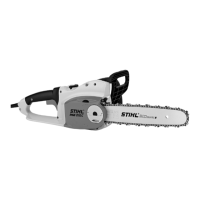MSE 170 C, MSE 190 C, MSE 210 C, MSE 230 C
English
13
Sapwood cuts
With long-fibered wood, sapwood cuts
prevent the sapwood from splintering
when felling the trunk – saw both sides
of the trunk at the level of the felling
notch base to approx. 1/10 of the
diameter of the trunk – with thicker
trunks, not more than the width of the
guide bar.
Do not use sapwood cuts on diseased
trees.
Backcutting principles
Basic dimensions
The felling notch (C) determines the
direction of fall.
The hinge (D) functions like a real hinge
to guide the tree to the ground.
– Width of hinge: approx. 1/10 of the
trunk diameter
– Never saw through the hinge while
felling – otherwise the tree will fall in
a direction other than the one
planned – risk of accident!
– With rotten trunks, leave a wider
hinge
The tree is felled with the backcut (E).
– Exactly horizontal
– 1/10 (min. 3 cm) of the width of the
hinge (D) across the bottom of the
felling notch (C)
The holding wood (F) or safety strip (G)
supports the tree and secures it against
premature falling.
– Width of strip: approx. 1/10 to 1/5 of
the trunk diameter
– Do not cut into the strip during the
backcut
– With rotten trunks, leave a wider
strip
Plunge cutting
– For relieving cuts during bucking
– For wood carving
N Use a low kickback chain and be
especially cautious
1. Begin the cut by applying the lower
portion of the guide bar tip – do not
use the upper portion – risk of
kickback! Cut at full strength until
the depth of the kerf is twice the
width of the guide bar

